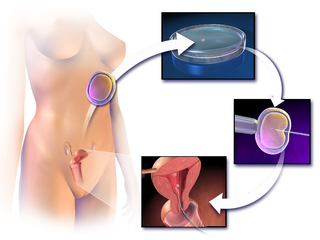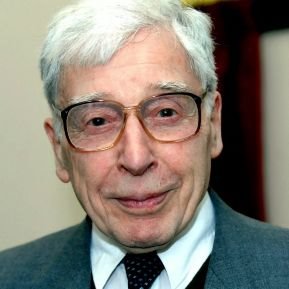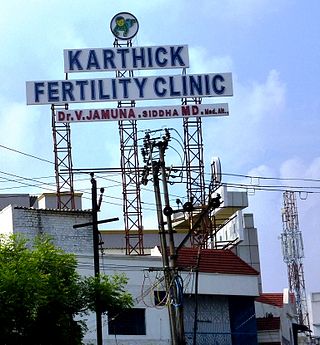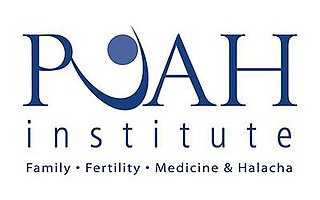Related Research Articles

In vitro fertilisation (IVF) is a process of fertilisation where an egg is combined with sperm in vitro. The process involves monitoring and stimulating a woman's ovulatory process, removing an ovum or ova from their ovaries and letting a man's sperm fertilise them in a culture medium in a laboratory. After the fertilised egg (zygote) undergoes embryo culture for 2–6 days, it is transferred by catheter into the uterus, with the intention of establishing a successful pregnancy.
Reproductive technology encompasses all current and anticipated uses of technology in human and animal reproduction, including assisted reproductive technology (ART), contraception and others. It is also termed Assisted Reproductive Technology, where it entails an array of appliances and procedures that enable the realization of safe, improved and healthier reproduction. While this is not true of all people, for an array of married couples, the ability to have children is vital. But through the technology, infertile couples have been provided with options that would allow them to conceive children.

Infertility is the inability of an animal or plant to reproduce by natural means. It is usually not the natural state of a healthy adult, except notably among certain eusocial species. It is the normal state of a human child or other young offspring, because they have not undergone puberty, which is the body's start of reproductive capacity.

Assisted reproductive technology (ART) includes medical procedures used primarily to address infertility. This subject involves procedures such as in vitro fertilization (IVF), intracytoplasmic sperm injection (ICSI), cryopreservation of gametes or embryos, and/or the use of fertility medication. When used to address infertility, ART may also be referred to as fertility treatment. ART mainly belongs to the field of reproductive endocrinology and infertility. Some forms of ART may be used with regard to fertile couples for genetic purpose. ART may also be used in surrogacy arrangements, although not all surrogacy arrangements involve ART. The existence of sterility will not always require ART to be the first option to consider, as there are occasions when its cause is a mild disorder that can be solved with more conventional treatments or with behaviors based on promoting health and reproductive habits.
Embryo donation is one disposition option for users of in vitro fertilisation with remaining fresh or frozen embryos. It is defined as the giving—generally without compensation—of embryos remaining after in vitro fertilization procedures to recipients for procreative implantation or research. Most IVF users with supernumerary embryos make embryo donation decisions after completing their families or discontinuing use of in vitro fertilization. Recipients of embryos donated for procreative implantation typically plan to transfer fresh or frozen embryos into a prepared uterus in order to facilitate pregnancy and childbirth. Recipients of embryos donated for research typically use them for clinical training, quality improvement research, or human embryonic stem cell research.

Georgeanna Seegar Jones was an American reproductive endocrinologist who with her husband, Howard W. Jones, pioneered in vitro fertilization in the United States.

Sir Robert Geoffrey Edwards was a British physiologist and pioneer in reproductive medicine, and in-vitro fertilisation (IVF) in particular. Along with obstetrician and gynaecologist Patrick Steptoe and nurse and embryologist Jean Purdy, Edwards successfully pioneered conception through IVF, which led to the birth of Louise Brown on 25 July 1978. They founded the first IVF programme for infertile patients and trained other scientists in their techniques. Edwards was the founding editor-in-chief of Human Reproduction in 1986. In 2010, he was awarded the Nobel Prize in Physiology or Medicine "for the development of in vitro fertilization".

Reproductive medicine is a branch of medicine concerning the male and female reproductive systems. It encompasses a variety of reproductive conditions, their prevention and assessment, as well as their subsequent treatment and prognosis.

Fertility clinics are medical clinics that assist couples, and sometimes individuals, who want to become parents but for medical reasons have been unable to achieve this goal via the natural course. Clinics apply a number of diagnosis tests and sometimes very advanced medical treatments to achieve conceptions and pregnancies.

Peter Robert Brinsden MBBS, MRCS, LRCP, FRCOG is known for the treatment of infertility in couples. From 1989 to 2006 he was the medical director of Bourn Hall Clinic in the UK, a leading centre for the treatment of fertility problems, and where about 6,000 babies have been conceived using IVF and other assisted conception treatments.
The Birmingham Women's Fertility Centre at Birmingham Women’s Hospital, Birmingham, England, formerly named the "Assisted Conception Unit", is one of the UK's leading medical centres for infertility treatment and care. It is the longest established fertility clinic in the Midlands, marking thirty years operations in the year 2010. The clinic is based in an NHS hospital and provides integrated care to both NHS and private patients; the staff is internationally recognised for their work in treating with infertility. The clinic runs active programmes of egg-sharing, sperm donation and egg-donation.
The Genetics & IVF Institute (GIVF) is an international provider of infertility and genetics services and products, and also engages in biomedical research in these fields. The Institute was founded in 1984 by Dr. Joseph D. Schulman and associates. GIVF headquarters are in Fairfax, VA, US, and its facilities include locations in Pennsylvania, Minnesota, California, and Texas in the United States, as well as in China, Mexico, and several other countries.

The PUAH Institute is an Israel-based, international organization that works with Jewish couples with fertility problems. PUAH was founded in 1990 at the request of Rabbi Mordechai Eliyahu to bridge the gap between fertility treatment and Jewish law.
Reproductive surgery is surgery in the field of reproductive medicine. It can be used for contraception, e.g. in vasectomy, wherein the vasa deferentia of a male are severed, but is also used plentifully in assisted reproductive technology. Reproductive surgery is generally divided into three categories: surgery for infertility, in vitro fertilization, and fertility preservation.
John Charles Rock was an American obstetrician and gynecologist. He is best known for the major role he played in the development of the first birth control pill.
Partner-assisted reproduction, reception of oocytes from partner (ROPA), reciprocal IVF,shared motherhood, partner IVF or co-IVF is a method of family building that is used by couples who both possess female reproductive organs. The method uses in vitro fertilization (IVF), a method that means eggs are removed from the ovaries, fertilized in a laboratory, and then one or more of the resulting embryos are placed in the uterus to hopefully create a pregnancy. Reciprocal IVF differs from standard IVF in that two partners are involved: the eggs are taken from one partner, and the other partner carries the pregnancy. In this way, the process is mechanically identical to IVF with egg donation. Reciprocal IVF offers the highest chance for pregnancy and a lower chance of a multiple births.
Jacques Cohen is a Dutch embryologist based in New York, U.S. He is currently a Director at Reprogenetics LLC, Laboratory Director at ART Institute of Washington at Walter Reed National Military Medical Center, and Scientific Director of R & D at IVF-online.

Howard Wilbur Jones, Jr. was an American gynecological surgeon and in vitro fertilization (IVF) specialist. Jones and his wife, Georgeanna Seegar Jones, were two of the earliest reproductive medicine specialists in the United States. They established the reproductive medicine center that was responsible for the birth of the first IVF baby in the U.S. He wrote articles on the beginning of human personhood and testified before legislators on the same subject. He was one of the early physicians to perform sex reassignment surgeries.
Norbert Gleicher is an American obstetrician-gynecologist active in obstetrical practice, in vitro fertilization, reproductive endocrinology, and reproductive immunology. He is a fellow of the American College of Obstetricians and Gynecologists (FACOG) and the American College of Surgeons (ACS) and currently serves as president, medical director and chief scientist of the Center for Human Reproduction (CHR) in New York City, a clinical fertility center that he founded in 1981. Simultaneously, he is President of the Foundation for Reproductive Medicine, a not-for-profit research foundation. Gleicher maintains additional academic appointments at Rockefeller University, and Medical University of Vienna.
Catharyn Johanna Stern is a clinical associate professor, and gynaecologist at Waverley Private Hospital in Melbourne, Victoria. She was appointed an Officer of the Order of Australia for distinguished service to gynaecology, reproductive medicine and fertility research. Stern has been a member of the Australian Medical Association (AMA) member for 23 years. Her award was for her services to gynaecology, to reproductive medicine and fertility research, and to the community.
References
- ↑ "Milton Leong". Pubfacts.com. Retrieved 14 October 2014.
- ↑ "The Women's Clinic homepage". Thewomensclinic.com.hk. Retrieved 14 October 2014.
- ↑ "Infertility is rising in Hong Kong, and the city lacks medical staff in the field". South China Morning Post. Retrieved 14 October 2014.